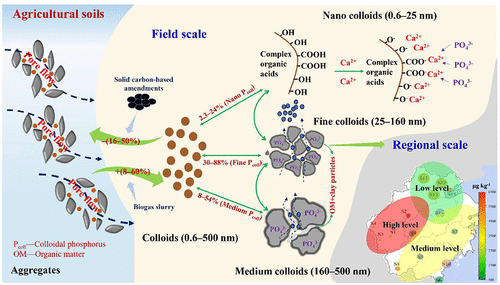当前位置:
X-MOL 学术
›
Environ. Sci. Technol.
›
论文详情
Our official English website, www.x-mol.net, welcomes your
feedback! (Note: you will need to create a separate account there.)
Organic Carbon Linkage with Soil Colloidal Phosphorus at Regional and Field Scales: Insights from Size Fractionation of Fine Particles
Environmental Science & Technology ( IF 10.8 ) Pub Date : 2021-04-15 , DOI: 10.1021/acs.est.0c07709 Fayong Li 1, 2 , Qian Zhang 3, 4 , Erwin Klumpp 3 , Roland Bol 3, 5 , Volker Nischwitz 6 , Zhuang Ge 7 , Xinqiang Liang 1
Environmental Science & Technology ( IF 10.8 ) Pub Date : 2021-04-15 , DOI: 10.1021/acs.est.0c07709 Fayong Li 1, 2 , Qian Zhang 3, 4 , Erwin Klumpp 3 , Roland Bol 3, 5 , Volker Nischwitz 6 , Zhuang Ge 7 , Xinqiang Liang 1
Affiliation

|
Nano and colloidal particles (1–1000 nm) play important roles in phosphorus (P) migration and loss from agricultural soils; however, little is known about their relative distribution in arable crop soils under varying agricultural geolandscapes at the regional scale. Surface soils (0–20 cm depth) were collected from 15 agricultural fields, including two sites with different carbon input strategies, in Zhejiang Province, China, and water-dispersible nanocolloids (0.6–25 nm), fine colloids (25–160 nm), and medium colloids (160–500 nm) were separated and analyzed using the asymmetrical flow field flow fractionation technique. Three levels of fine-colloidal P content (3583–6142, 859–2612, and 514–653 μg kg–1) were identified at the regional scale. The nanocolloidal fraction correlated with organic carbon (Corg) and calcium (Ca), and the fine colloidal fraction with Corg, silicon (Si), aluminum (Al), and iron (Fe). Significant linear relationships existed between colloidal P and Corg, Si, Al, Fe, and Ca and for nanocolloidal P with Ca. The organic carbon controlled colloidal P saturation, which in turn affected the P carrier ability of colloids. Field-scale organic carbon inputs did not change the overall morphological trends in size fractions of water-dispersible colloids. However, they significantly affected the peak concentration in each of the nano-, fine-, and medium-colloidal P fractions. Application of chemical fertilizer with carbon-based solid manure and/or modified biochar reduced the soil nano-, fine-, and medium-colloidal P content by 30–40%; however,the application of chemical fertilizer with biogas slurry boosted colloidal P formation. This study provides a deep and novel understanding of the forms and composition of colloidal P in agricultural soils and highlights their spatial regulation by soil characteristics and carbon inputs.
更新日期:2021-05-04





















































 京公网安备 11010802027423号
京公网安备 11010802027423号